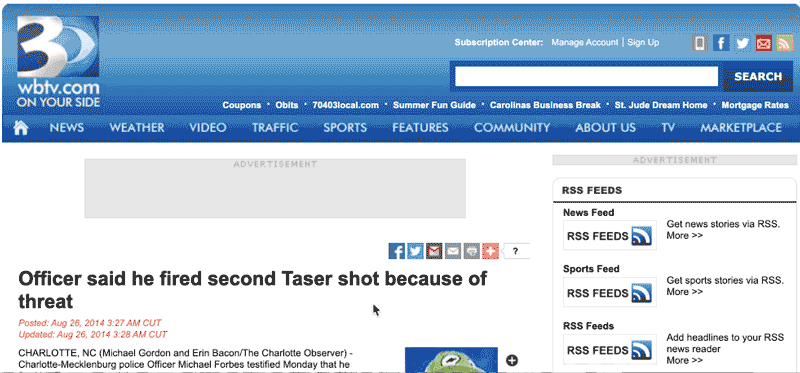CHARLOTTE, NC (Michael Gordon and Erin Bacon/The Charlotte Observer) –
Charlotte-Mecklenburg police Officer Michael Forbes testified Monday that he fired his Taser a second time at an assault suspect sitting on a sidewalk in 2011 because he still considered the man a threat.
After that second shock, La-Reko Williams’ heart stopped beating.
Now the federal lawsuit filed by his parents against Forbes hinges on whether a jury believes the officer used reasonable force against Williams or needlessly shocked a helpless man.
Forbes was never charged with a crime. In their lawsuit, the family is asking for more than $10,000 in damages on a variety of counts.
Forbes’ first Taser shot on the night of July 20, 2011, knocked Williams to the ground outside the Woodlawn light-rail station. The officer said he fired again 13 seconds later because the 21-year-old Williams refused numerous orders to lie on his stomach to be handcuffed and was struggling to get to his feet.
U.S. District Judge Max Cogburn has already granted Forbes immunity for immobilizing Williams with a stun gun the first time.
Tuesday, both sides in the weeklong trial went to great lengths to frame the pivotal second shock for the five-woman, three-man jury.
Forbes teamed with an assistant city attorney to re-create his struggle with Williams. Later, a family attorney cross-examined the police officer for a few minutes while sitting on the floor of the courtroom, mimicking Williams’ position at the time of the second shock.
When defense attorney Lori Keeton played the audio and video of the night’s events, Williams’ parents left the room.
Out in the lobby, Tamako McCarthy and Anthony Williams said they had seen and heard enough from the recordings.
“What mother wants to watch her son die over and over?” McCarthy said.
Throughout his 2 1/2 hours of testimony, the uniformed Forbes described his use of force as necessary and justified. Williams, the officer said, had ignored his commands and shoved him twice before Forbes first shocked him.
He said he used the Taser on Williams again because if the suspect got to his feet, “We were going to be right back where we started.”
Asked by defense attorney Lori Keeton to explain, Forbes said, “He was going to assault me.”
Forbes was the first officer to respond after police received at least five 911 calls reporting a fight between a man and a woman at the Woodlawn station. Callers described a dreadlocked man in basketball shorts, later identified as Forbes, choking and punching a woman – Destiny Franklin, Williams’ girlfriend at the time.
Forbes said the two were still “tugging and pulling” at each other when he drove up. Williams tried to leave. Forbes followed, ordering Williams to stop and show an ID, according to a police audio from the scene.
Williams responded that he was leaving, then asked over and over: “Stopped for what?”
The officer said he grabbed Williams’ arm, but the suspect spun free and pushed him in the chest. The audio captured the back-and-forth:
“Get off me,” Williams shouted.
“You want to get tased?” Forbes replied in a rising voice.
Eventually, Forbes ordered Williams to get on the ground. When he didn’t comply, Forbes said he again reached for Williams’ arm to handcuff him. Once more Williams pushed him, Forbes said, then turned toward him with fists clenched at his waist. The two men, both about 5-foot-6, stood 5 to 10 feet apart.
Forbes said he pulled his Taser and aimed it at Williams’ chest – and the large mass of muscles there that would lock up and immobilize Williams once they were hit by the electric probes.
Then he fired – the pop clearly audible on the recording.
Williams fell straight back, landing on the sidewalk and nearby grass with his legs straight out. On the audio, Forbes twice orders Williams’ girlfriend to stay away, then yells a series of orders at the downed Williams, shouting at one point, “Get on your stomach or you’re going to get tased again!”
Over the next 10 seconds, Forbes shouted orders as Williams repeatedly asked why he had been detained. Forbes testified that Williams was pushing down on the ground with his arms to get to his feet. Then, he was shocked with a Taser a second time and his voice was not heard again in the courtroom.
Forbes told Keeton that up to the time he handcuffed Williams after the second Taser shot, he still considered him dangerous.
During cross-examination, Greensboro attorney David Ventura asked him why.
Several of the 911 calls said that neither Williams nor Destiny Franklin appeared to be armed, and no weapons were found, Ventura said.
If Williams indeed clenched his fists before the first Taser shot and tried to get to his feet before the second, why did no one else at the scene witness those actions?
And if the police department trains officers that, for safety reasons, the “preferred target” for tasing is at the stomach or below, why did Forbes shoot so high?
At one point, Ventura stretched out on the floor, then rose up to a sitting position, just as Forbes described Williams doing in the aftermath of the first tasing.
Did Forbes, the lawyer asked, still consider Williams to pose an imminent threat while he was sitting on the ground with little use of his legs?
Given “the totality of the circumstances,” the officer replied, yes he did.
The jury could begin deliberation as soon as Tuesday afternoon.


Recent Comments